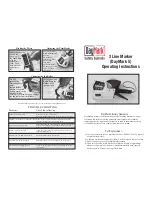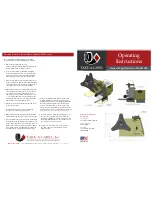
7
Reverse Door Catch
1. Remove the hole plugs from the opposite side of the door
and set aside.
2. Remove the screws from the magnetic door catch and
replace it on the opposite side of the door.
3. Push the hole plugs into place on the opposite side of the
door.
4. Plug into a grounded 3 prong outlet.
Normal Sounds
Your new ice maker may make sounds that are not familiar to
you. Because the sounds are new to you, you might be
concerned about them. Most of the new sounds are normal. Hard
surfaces such as floors, walls and cabinets can make the sounds
seem louder than they actually are. The following describes the
kinds of sounds that might be new to you and what may be
making them.
■
You will hear a buzzing sound when the water valve opens to
fill the water reservoir for each cycle.
■
Rattling noises may come from the flow of the refrigerant or
the water line. Items stored on top of the ice maker can also
make noises.
■
The high-efficiency compressor may make a pulsating or high
pitched sound.
■
Water running over the evaporator plate may make a
splashing sound.
■
Water running from the evaporator plate to the water reservoir
may make a splashing sound.
■
As each cycle ends, you may hear a gurgling sound due to
the refrigerant flowing in your ice maker.
■
You may hear air being forced over the condenser by the
condenser fan.
■
During the harvest cycle, you may hear a “thud” when the ice
sheet slides from the evaporator onto the cutter grid.
■
When you first start the ice maker, you may hear water
running continuously. The ice maker is programmed to run a
rinse cycle before it begins to make ice.
ICE MAKER USE
How Your Ice Maker Works
When you first start your ice maker, the water pan will fill and the
system will rinse itself before starting to make ice. The rinsing
process takes about 5 minutes.
Under normal operating conditions, the ice maker will cycle at
preset temperatures. The ice level sensor located in the ice
storage bin will monitor the ice levels.
IMPORTANT:
■
If the water supply to the ice maker is turned off, be sure to
set the ice maker control to OFF.
■
The ice maker is designed to make clear ice from the majority
of water sources on a daily basis. If your results are
unsatisfactory, your water may need to be filtered or treated.
The Ice Making Process
1. Water is constantly circulated over a freezing plate. As the
water freezes into ice, the minerals in the water are rejected.
This produces a sheet of ice with a low mineral content.
2. When the desired thickness is reached, the ice sheet is
released and slides onto a cutter grid. The grid divides the
sheet into individual cubes.
Electrical Shock Hazard
Plug into a grounded 3 prong outlet.
Do not remove ground prong.
Do not use an adapter.
Do not use an extension cord.
Failure to follow these instructions can result in death,
fire, or electrical shock.
WARNING








































